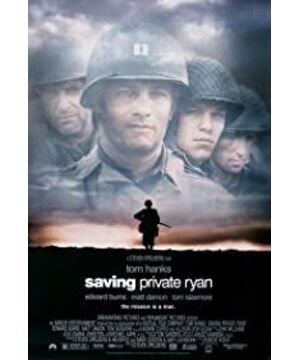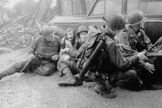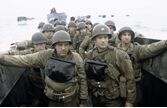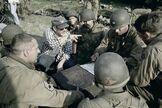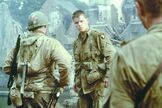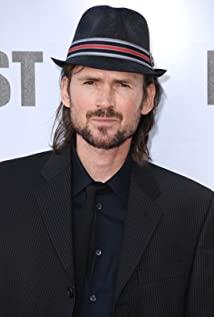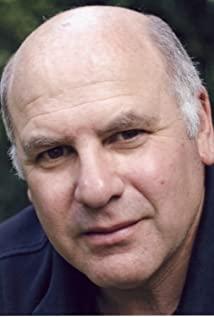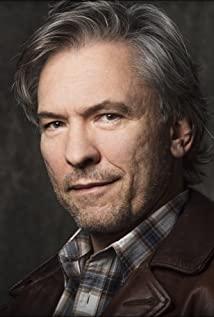-the integration
of multiple narratives. There are many movies about World War II. "Saving Private Ryan" is a small view, and through the story of searching for private Ryan, it expresses the reflection on the war. And the point of view of human nature.
The story is not bizarre, it can be said to be quite simple. "Plain and understandable" is straightforward and cliché. This makes the narrative framework of the movie simple and unfresh, and it is difficult to impress the audience's heart-the cheap and thick-skinned fish burnt dinner is not delicious, even if the fish is actually deep in thought, the audience will not buy it. But "good quality and low price" can't be given up easily. It is both cheap and real products, so that the audience can buy it, which is very troublesome!
Don't worry, after eating this bowl of rice, practitioners have their own tricks. There are so many weird movies in the world, each with its own merits, looks energetic and interesting, all because of their different tactics. To do such a greedy thing as filling the stomachs of the audience and moving their hearts, it is necessary to use a knife on the fish, but this is obviously not enough-anyone can cook it, and the poor fish cannot escape being caught by the crowd. The fate of successive surgeries, if you decide on it again, I'm afraid it's about to be performed on the fish bones.
How to find new points and make new ideas? "Saving Private Ryan" is a good case.
Movies are different from other commodities. They directly face the audience's senses, arouse their many feelings and feelings, and point to their emotions, thoughts and spiritual world. The bottom layer is the material attribute. Movies are a kind of spiritual consumption of people. This is the primary consideration of the "Master Chef", and the rest are subsidiary.
The narrative of the film, its language should meet the sensory needs of the audience, tap their multi-level perceptions and feelings, and integrate them, so as to continuously make him feel rich. They triggered and collided with each other, reaching the soul, making him feel. This complicated process allows the audience to experience not only sensory satisfaction, but also a deep spiritual satisfaction through watching the movie. It even made him reflect, and the aftermath lingered at the end of the film, entering deeper into his mind, infiltrating his thoughts and feelings, affecting his existing concepts, and "depositing" into his brain as fresh blood—
many films were produced in the world, making How many have reached this level?
I think "Saving Private Ryan" did it.
It fills the cheap big fish maw with delicious small fish, which greatly improves the taste of the big meal. And, more than that, delicious small shrimps are stuffed into Xiaoyu's belly to make the movie more refined and meet the needs of the audience mentioned above. In other words, "Saving Private Ryan" uses a multi-integrated narrative method to make the film more refined, more authentic, and better-looking. It successfully told the story. Good evaluation and word of mouth are proof.
More importantly, it has gained freedom of expression in such a way.
why? This can be reasonably explained from the theoretical level:
all the mental activities of people, the "headquarters in chief" is in the brain. The human brain is divided into left and right hemispheres. Each division is rational and sensible, both division of labor and cooperation. Movies mainly act on sensibility, especially human thinking in images-thinking in images can be traced back to ancient times, and it occupies an important position in people's lives today, and its weight far exceeds abstract thinking such as words. A film, the more vivid it wants to "speak", the better the effect it will achieve.
The principle of multiple integration lies in 1+1>2. A movie must allow the audience to fully mobilize all senses in the process of watching the movie. Participation can not only reduce the loss of information in the process of passive reception, but also enhance the audience's experience through reinforcement, and the transmission effect will be enhanced.
More importantly, multiple integration is not only a simple integration, but also a creation. In the integration process, the collection of various narrative methods can create new meanings and bring fresh feelings to the audience; and the high participation of the audience can stimulate the collision between his existing ideas and the ideas that the film wants to express. This collision will make ideas spread better.
These are the two main features of the film's narrative that I have isolated, and another feature is that it is good at creating suspense. These three characteristics are mixed together in an orderly manner, making the movie very "good-looking", and "good-looking" is the highest evaluation that an ordinary audience can give a movie.
Now, let’s go back to the question at the beginning: how to cook big fish? ——The movie uses the three-stage grand narrative structure most commonly used in feature films, namely present-past-present. That is to cut in from the present tense and tell the story of the past in an intermittent way. This is reflected in the beginning of the film.
1. At the beginning of the film, the transition from the present tense to the past tense completes the big narrative structure.
In the sound of military music, the first picture that appears at the beginning of the film is the American flag fluttering in the wind, and the entire picture is used to highlight it. This is not superfluous, but a preview of the beginning of the narrative. It also explains the background of part of the story and contrasts with the ending credits. I seem to see that, before the story has been told, a large and vague outline has been drawn. In addition, it also contains some ideological information: this is the story of World War II told by the Americans.
The first entry shot is the back of old Ryan. The camera first gave him a brief close-up of his feet, then moved up. Through the activities of the old Ryan, a panoramic view of the cemetery appeared on the screen. The wide green space and the all-white cross tombstone brought the first visual impact. The camera gives a close-up of the tombstone. Although the audience is not yet clear about the background of the story, they have already experienced the implicit meaning of "behind each tombstone are life". At the same time, the old man is a war survivor, this identity is revealed (Ryan's ultimate identity is not revealed until the end of the story).
The look, especially the look in the eyes, is the "spokesperson" of the next shot. When the old man looked distressed and couldn't help squatting on the ground, his family came up to surround him, and the camera started to move towards the old man, the audience had a premonition that the movie was about to "say" something. Sure enough, the lens was pushed straight to the old man's eyes, with a close-up. With this rhythm, the sound of the ocean tide is added to the military music, and it gets stronger and stronger as the shot goes on. After reaching the high tide at the same time, the camera immediately shifted to the surging coast.
Since then, the story has officially entered the past from the present. It's really paving the way and less nonsense.
There is one more detail here, which is about color, which is worth mentioning. With the sound of a wave, the picture suddenly shifted from the bright now to the gloomy coastline. Characters, sound, and colors work together to narrate together to help the audience adapt and understand the transition of the scene and the change of the story content. I also noticed that the weird steel arrangement and the cross tombstones in the scene before the transition form a symmetry, which makes the narrative in the scene have a continuity. Here, the multiple integrated narrative skills have been demonstrated, and such ingenious ideas are really everywhere in the film, forming a unity of style and temperament, which is admirable.
The direction of the big fish has already been eye-catching, how should the small fish and shrimps be arranged? The specific methods and techniques are too rich to be counted, let alone generalized. Let's pick the first few to talk about.
2. The multiple narrative skills
in the Normandy Landing After the scene is transformed into the characters, the narration of the Normandy Landing officially begins. The language of this movie is very exciting, and it vividly creates a kind of "movie reality", which is admirable.
Choose two details here-water scenes and surreal shots-let's talk about it.
① The non-daily landscape narrative strengthens the theme. When the
ship is about to dock and land, as the soldiers jump off the ship, the narrative scene shifts from the daily landscape into the water. Since people generally live on land, their underwater activities are relatively non-daily sights. This not only creates trouble for narrative, but also creates opportunities for narrative. I don’t know if the movie was deliberately-adding this paragraph to better express the theme-at least it left a deep impression on me.
At the beginning, the camera captured the picture of soldiers falling into the water while the camera was underwater, and at the same time the sound changed-the sky-shaking artillery shells, machine guns, and bullets suddenly subsided, and the fierce fighting atmosphere created by them suddenly broke. However, the underwater is not completely calm. In such a special scene, the audience still hears the sound of guns and guns from outside the painting, and bullets are shot directly into the water, while inside the painting is water produced by soldiers struggling and moving. Voice. Perhaps because people live in amniotic fluid when they are babies, the water gives people a sense of security subconsciously. However, in this age of war, there is nowhere to escape. In this cruel forest of lethal weapons, no one can avoid Detachment——The flexible body of water failed to block the sharp bullets. Two soldiers who were untying their belts were shot by stray bullets rushing into the water. The blood water immediately dyed the scene in front of the audience red; a soldier pulled the belt on his body with his face Struggling fiercely in the water in pain, the action gradually stiffened; the camera did not stop, with the movement of people, it returned to the broken war scene. However, within this 30-second period, on the one hand, there is the noise of the external sound, on the other hand, the silence when life is gone. It is highlighted side by side in the multiple mixed narrative. Everything is so natural, there is no excessive rendering, no Excited accusations, but powerfully exposed the cruelty and unreasonableness of the war.
So far, this waterscape has been successful. Its existence not only enriches the audience experience, but also strengthens the theme of the movie and expresses a wealth of content.
What needs to be added is that such "irrelevant narratives", which seem to have nothing to do with the story itself, are interspersed with time and time in the plot of the Normandy landing, and there is no lack of echoes throughout the film. Although this is expressing the fierceness of war and supporting the film with various details, the deeper level is that the film conveys a perspective on war through a panoramic view beyond mere mortals and through intuitive language of pictures. The concept of film has gone beyond narrative and "speaking". It is difficult for you to tell exactly what it "said", but you can feel it in the movie. No roll of film is used to waste, and the audience knows that when something is repeated more than the limit, it must be what the film is "saying" from it. This is part of the overall understanding of the movie, so I mention it.
②The surreal subjective lens made the narrative richer. Fierce
battles have continued for some time, the scenes are chaotic, and American soldiers have landed one after another. The lens always takes the general angle, and the picture appears disorderly and out of focus. However, after a powerful shell exploded into the left leg of a soldier, the camera shifted to the right and suddenly moved forward like a target. A soldier who climbed ashore gradually entered the center of the screen. The lens finally focused on his face, and when the close-up was given, the sound and picture suddenly separated. The violent artillery fire suddenly disappeared and disappeared, subtracted, replaced by a surreal air blast, and the audience suddenly didn't know what happened. As the narrative progresses, the audience understands from various signs that this is a surreal subjective lens.
This soldier looks "unique" (Tom Hanks) and has an extraordinary expression. With a close-up shot, he immediately replaces the side branch as the center and protagonist of the narrative. His subjective experience, his sight, became the main narrative content-he looked to the left, a young soldier called a group under the steel frame in fear; he looked to the right, the artillery fire engulfed three soldiers one after another; he Looking forward, a soldier with a broken arm looked around his arm and ran with the broken arm after he found it.
This subjective lens that breaks the normal narrative and "detaches" from it, completes the side "description" and subjective experience of war that cannot be completed by the normal narrative, giving the narrative a sense of hierarchy. However, the normal narrative is not completely broken, the subjective narrative does not dominate everything, the film also uses other auxiliary methods, and the soldier himself has become the narrative "prop". The situation when he enters the picture itself assumes the narrative function. As the narrative progressed, his face was full of blood, his reaction to the cannonballs, the blood on his head when he emptied the helmet, the resolute expression of the face when the blood was flowing down, and the mouth shape of the soldiers shouting when the camera was shot back. It's all narrating, "speaking".
And the breaking of the surreal narrative is also through him. When the air chirping became stronger, the camera again gave him a close-up. At this time, the air chirp added a sound similar to that of an airplane taking off, and the scene exploded. When the sound returned again, the shouts that had been "abnormally processed" reappeared, and the narration returned to normal.
The whole conversion, coming and going freely, is so perfect and unified, and the integration is seamless. Each element is highly integrated into a whole while undertaking their respective functions. Rather than destroying the continuity of the film, the rupture strengthens its internal connection, which is really wonderful.
There are many exciting parts of "Saving Private Ryan", limited to space, no longer going in depth.
View more about Saving Private Ryan reviews


